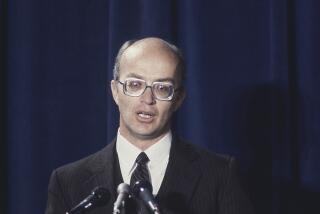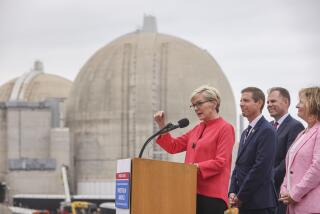Gore’s Position on Ohio Waste Site Questioned
- Share via
WASHINGTON — Vice President Al Gore, who has portrayed himself as a champion of environmental concerns, reneged on a 1992 campaign promise to shut down a controversial hazardous waste incinerator near an elementary school in Ohio, according to testimony provided recently in a federal investigation.
According to testimony by William K. Reilly, who served as administrator of the Environmental Protection Agency from 1988 to 1993 under then-President Bush, Gore sent word after his election as vice president that he “had second thoughts” about keeping the incinerator from opening at East Liverpool, Ohio, and preferred that the EPA proceed with granting a trial burn permit.
Reilly said he received this word at a meeting in his office with Kathleen McGinty, Gore’s chief environmental advisor at the time. McGinty, in her own sworn statement, said that she did not recall meeting with Reilly on the incinerator issue but would not dispute his account.
McGinty recently told EPA ombudsman Robert Martin, who was asked to investigate the incinerator controversy by Gore last February, that “I respect him [Reilly] tremendously and I wouldn’t contradict him.” But McGinty added that “I never recall being asked our opinion as to whether or not it should go forward.”
She testified that after taking office, Gore “expressed his commitment to ensure that this facility was safe and would be tested thoroughly to ensure it was safe.”
A transcript of testimony in the case was obtained and made public by Ohio Citizen Action, an environmental group.
Gore spokesman Jim Kennedy said Wednesday that all people involved in the 1992-93 Clinton-Gore transition team “were very careful not to influence any pending government decisions because it would have been highly inappropriate to do so.” Gore told a Pittsburgh television station last March that his “hands were tied” because the Bush administration “went ahead and did it after the election but before the inauguration.”
And McGinty, who said Wednesday that the transition team had never recommended that the outgoing Bush administration take certain actions, questioned the timing of the disclosure.
“I find the timing of Reilly’s account very suspicious, coming just a few days before a hotly contested election,” she said.
The Republican campaign of Texas Gov. George W. Bush in recent weeks has hammered hard on the issue of Gore’s credibility, and Green Party candidate Ralph Nader has used the incinerator issue in mailings to environmentalists as one reason why they should vote for him over Gore.
The facility is on the Ohio River, about 1,000 feet from a 400-student elementary school and 30 miles west of Pittsburgh. Operated by Waste Technologies Inc., the incinerator burns 60,000 tons of hazardous waste a year.
During the 1992 campaign, Clinton and Gore stopped in East Liverpool and criticized the Bush administration’s environmental record, adding that they would not allow the controversial facility to open until community concerns had been met and it had been proved safe.
But Reilly, now head of an investment firm that cleans up water in developing nations, described his January 1993 conversation with McGinty this way, according to the transcript:
“She said the vice president had had second thoughts about his position, had concluded that he should not interfere in the regulatory process and that the transition team would be grateful, the vice president would be grateful if I simply made that decision before leaving office.”
McGinty said Wednesday that she wished to elaborate on her testimony by saying that, “despite what Reilly says, there was no instance in which during the transition we were suggesting what regulatory decisions should be made” by the outgoing administration.
Kennedy said that Gore supports a recommendation made last month by Martin, the EPA ombudsman, that the incinerator should be closed down for six months while new testing techniques are used to determine its safety.
Despite persistent protests from some members of the community, the plant was granted an operating permit before the Clinton administration took office.
But the federal EPA and Ohio Environmental Protection Agency since have recorded more than 100 equipment and procedural violations, including 27 fires and two explosions, at the facility. The plant has operated on interim licenses since 1995.
Last November, the Ohio EPA began an enforcement action against the company that included a civil penalty of $126,000. In June, the federal EPA reclassified the facility as a “significant non-complier.”
More to Read
Get the L.A. Times Politics newsletter
Deeply reported insights into legislation, politics and policy from Sacramento, Washington and beyond. In your inbox twice per week.
You may occasionally receive promotional content from the Los Angeles Times.









